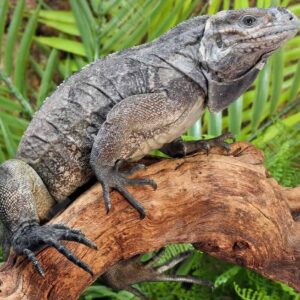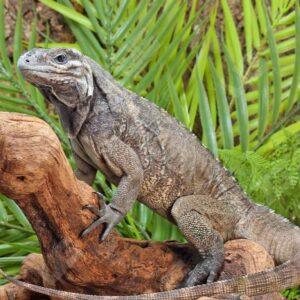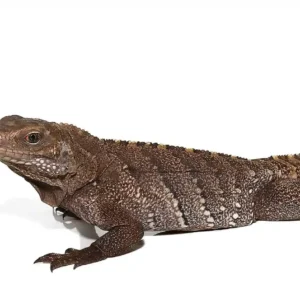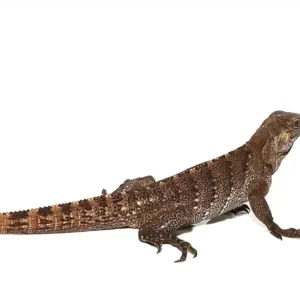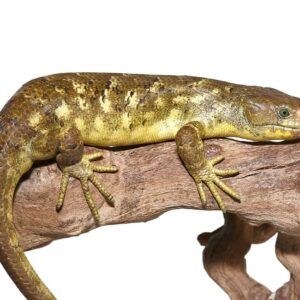Grand Cayman Blue Iguana For Sale
$599.99
WE HAVE GRAND CAYMAN BLUE IGUANA FOR SALE. HERE ARE SOME HIGHLIGHTS:
- Cyclura lewisi Hybrid
- Captive Bred
- Approximately 12 – 14 Inches From Head To Tail
- Adults Are Averaging In Sizes Around 4-5 Feet In Length
- Feeding On Vitamin Dusted Vegetables, Fruits, Greens And Iguana Diet
FUN FACTS!
- This Is An Extremely Smart Species That Makes For An Awesome Pet
- These Gain Color As They Grow Coming Into Hues Of Blue As Adults
- Naturally Occurring In The Cayman Islands Just South Of Cuba In The Caribbean Sea
- Living Their Lives Along The Tropical Islands These Iguanas Thrive In Hot Humid Climates
- Can Live Up To 50+ Years In Captivity With Proper Care
Description
The Grand Cayman Blue Iguana, scientifically known as Cyclura lewisi, is a remarkable species endemic to the island of Grand Cayman. Renowned for its striking blue coloration, this iguana stands out distinctly from other iguana species. The vibrant hue is most pronounced in adult males, particularly during the breeding season, as it serves as a visual signal to potential mates and rivals.
Beyond its captivating appearance, the Grand Cayman Blue Iguana boasts several unique characteristics. It is one of the largest native land animals in the Cayman Islands, with adults reaching lengths of up to five feet, including the tail. These iguanas exhibit a robust build, adorned with a prominent dewlap under their chin, and a dorsal crest running from the neck down to the tail.
The Grand Cayman Blue Iguana plays a crucial role in its ecosystem. As an herbivore, it primarily feeds on a variety of leaves, flowers, and fruits, which in turn helps in seed dispersal and maintaining the health of the local flora. The iguana’s foraging habits aid in the prevention of plant overgrowth, thus promoting biodiversity within its habitat.
Unfortunately, the Grand Cayman Blue Iguana has faced significant threats, primarily due to habitat destruction and predation by invasive species. Conservation efforts over the past few decades have been instrumental in bringing this species back from the brink of extinction. Today, ongoing initiatives focus on habitat restoration, breeding programs, and public education to ensure the survival of this majestic reptile.
The unique characteristics and ecological significance of the Grand Cayman Blue Iguana make it a symbol of conservation success and a vital component of the island’s natural heritage. Understanding and preserving this species is essential not only for maintaining ecological balance but also for appreciating the natural wonders of the Grand Cayman.
Habitat and Distribution
The Grand Cayman Blue Iguana, scientifically known as Cyclura lewisi, is predominantly found in the dry forests and shrublands of Grand Cayman Island. These unique reptiles have adapted to the island’s arid and rocky terrain, favoring sunlit areas where they can bask and regulate their body temperature. The dry forests provide ample foliage and cover, essential for their survival, while the shrublands offer a diverse array of plants that form a significant part of their diet.
On Grand Cayman Island, the Blue Iguanas are most commonly found in the eastern regions, particularly in the protected areas of the Queen Elizabeth II Botanic Park and the Salina Reserve. These regions are crucial for their conservation, providing a haven where they can thrive away from the threats of urban development and human encroachment. The distribution of the Blue Iguanas within these areas is influenced by the availability of food sources, suitable nesting sites, and the presence of natural predators.
Environmental factors such as temperature, humidity, and vegetation density play a significant role in shaping their habitat preferences. The Blue Iguanas prefer temperatures that range between 80 to 90 degrees Fahrenheit, and areas with lower humidity levels. This preference for specific climatic conditions underscores the importance of preserving their natural habitat, as any significant changes could adversely affect their population.
Moreover, the Blue Iguanas are territorial creatures, often establishing and defending their home ranges. These territories are typically centered around key resources such as food, water, and shelter. The fragmentation of their habitat due to human activities poses a serious threat to their survival, making conservation efforts and habitat restoration vital for maintaining their populations.
Understanding the habitat and distribution of the Grand Cayman Blue Iguana is essential for developing effective conservation strategies. Protecting their natural environment ensures that these majestic reptiles continue to be an integral part of the island’s biodiversity.
Diet and Feeding Habits
The Grand Cayman Blue Iguana, a remarkable inhabitant of the Cayman Islands, exhibits a predominantly herbivorous diet. This majestic reptile thrives on a variety of plant matter, with its dietary preferences largely centered around leaves, flowers, and fruits. Their herbivorous nature is a key aspect of their survival, providing them with the necessary nutrients to maintain their vibrant blue hue and robust health.
Leaves form a substantial portion of the Blue Iguana’s diet. These reptiles are known to forage on a diverse range of foliage from different plant species, which they meticulously select based on availability and nutritional content. In addition to leaves, flowers also play a crucial role in their diet. The consumption of flowers not only provides essential nutrients but also adds variety to their meals, ensuring a balanced intake of vitamins and minerals.
Fruits are another significant component of the Grand Cayman Blue Iguana’s diet. These iguanas exhibit a particular fondness for ripe fruits, which offer a sweet and energy-rich supplement to their regular intake of leaves and flowers. The seasonal availability of different fruits means that their diet can vary throughout the year. During periods when certain fruits are abundant, these iguanas adjust their feeding habits to take advantage of the nutritional bounty.
Foraging behavior in Blue Iguanas is both a solitary and meticulous activity. They spend considerable time exploring their habitat, using their keen sense of smell and sight to locate food sources. Their slow, deliberate movements ensure that they maximize their energy efficiency while foraging. Additionally, Blue Iguanas have been observed to exhibit specific feeding habits, such as consuming certain plants that may have medicinal properties to aid in digestion or general health.
Seasonal variations also influence the diet of the Grand Cayman Blue Iguana. During the wet season, when vegetation is more lush and abundant, their diet is richer in fresh leaves and flowers. Conversely, in the dry season, they may rely more heavily on available fruits and tougher plant materials. This adaptability in their feeding habits ensures their survival in the varying conditions of their natural habitat.
Reproduction and Lifespan
The reproductive cycle of the Grand Cayman Blue Iguana is a fascinating process that begins with distinct mating behaviors. Mating typically occurs during the spring, when males become more territorial and display vibrant colors to attract females. Courtship involves a series of head bobs, body displays, and physical nudges. Once a female is receptive, the pair will engage in copulation, which can last several minutes.
Following successful mating, the female Grand Cayman Blue Iguana embarks on the critical task of nesting. She seeks out a suitable location, often choosing sandy or loose soil where she can dig a burrow. Nesting sites are selected for their optimal conditions, ensuring that the eggs are protected and can develop properly. The female will lay a clutch of eggs, typically ranging from 5 to 20, which she then covers and leaves to incubate. The incubation period for these eggs lasts approximately 65 to 90 days, during which time the temperature and humidity of the environment play a crucial role in the development of the embryos.
The lifespan of the Grand Cayman Blue Iguana varies significantly between wild and captive environments. In the wild, these iguanas face numerous challenges, including predation, habitat destruction, and competition for resources, which can impact their longevity. On average, a wild Grand Cayman Blue Iguana may live for around 20 to 25 years. In contrast, those in captivity, benefiting from controlled conditions, regular veterinary care, and a consistent diet, can live up to 40 years or more. Factors influencing their lifespan include genetics, environmental stressors, and overall health care.
Understanding the reproductive cycle and lifespan of the Grand Cayman Blue Iguana is essential for their conservation. Efforts to protect their natural habitat and to support captive breeding programs are vital to ensuring the survival of this remarkable species. Each aspect of their life cycle, from mating to nesting and longevity, plays a significant role in maintaining the population of these majestic reptiles.
Conservation Status and Efforts
The Grand Cayman Blue Iguana, scientifically known as Cyclura lewisi, is classified as critically endangered by the International Union for Conservation of Nature (IUCN). This species, endemic to the Grand Cayman Island, has faced severe population declines, primarily due to habitat destruction and the introduction of invasive species. Over the years, significant efforts have been made to combat these threats and ensure the survival of this unique reptile.
Habitat destruction remains one of the most pressing challenges for the Grand Cayman Blue Iguana. Urban development, agricultural expansion, and road construction have led to the fragmentation and loss of its natural habitat. Additionally, invasive species such as feral cats and dogs pose a significant threat by preying on iguanas, particularly the young and eggs. Non-native plants have also altered the ecosystem, reducing the availability of essential food sources.
To counter these threats, a range of conservation efforts have been implemented. One of the most notable initiatives is the Blue Iguana Recovery Program (BIRP), established in 1990. This program has been instrumental in breeding and reintroducing iguanas into protected areas. Through captive breeding programs, the population of Grand Cayman Blue Iguanas has gradually increased, with hundreds of individuals being released into the wild.
Habitat preservation is another critical component of the conservation strategy. Efforts have been made to secure and restore natural habitats, such as the establishment of the Salina Reserve and the Queen Elizabeth II Botanic Park, which provide safe havens for the iguanas. These protected areas are monitored and managed to ensure a suitable environment for the species to thrive.
Public awareness and education campaigns have also played a vital role in conservation. By educating local communities and tourists about the importance of the Grand Cayman Blue Iguana and the threats it faces, these initiatives aim to foster a sense of stewardship and support for ongoing conservation efforts.
Through a combination of breeding programs, habitat preservation, and public engagement, significant strides have been made in protecting the Grand Cayman Blue Iguana. However, continued efforts and vigilance are essential to ensure the long-term survival of this magnificent reptile.
Role in the Ecosystem
The Grand Cayman Blue Iguana, often referred to as the Blue Iguana or Cyclura lewisi, plays a pivotal role in maintaining the ecological balance of its native habitat. This unique species is an integral part of the island’s ecosystem, significantly impacting vegetation and interacting with various species, thereby contributing to the overall health and sustainability of its environment.
One of the primary ways the Blue Iguana influences its habitat is through its diet. As a herbivore, it primarily consumes a wide variety of plant materials, including leaves, flowers, and fruits. This feeding behavior helps in the dispersal of seeds, which is crucial for the regeneration of flora. By spreading seeds through its feces, the Blue Iguana facilitates the growth of new plants, thus promoting biodiversity and ensuring the sustenance of the island’s rich vegetation.
Furthermore, the Grand Cayman Blue Iguana has symbiotic relationships with certain plant species. For example, some plants have evolved to produce fruits that are particularly appealing to these iguanas, thereby ensuring that their seeds are effectively dispersed. This mutualistic relationship benefits both the iguana and the plant species, highlighting the intricate connections within the ecosystem.
Additionally, the Blue Iguana’s burrowing activities create microhabitats that support other organisms. These burrows provide shelter for various invertebrates and small vertebrates, enhancing the habitat’s complexity and diversity. This, in turn, supports a wide range of species, from insects to birds, contributing to the overall health of the ecosystem.
The Grand Cayman Blue Iguana also plays an indirect role in controlling insect populations. By maintaining healthy vegetation through its feeding and seed dispersal activities, it supports a balanced ecosystem where predatory insects and their prey can thrive. This balance is crucial for preventing the overpopulation of any single species, which could otherwise lead to ecological imbalances.
In essence, the Grand Cayman Blue Iguana is a keystone species, whose presence and activities are vital for the stability and health of its native habitat. Its interactions with vegetation and other species underscore its importance in maintaining the delicate equilibrium of the ecosystem, making its conservation a priority for preserving the ecological integrity of the Grand Cayman.
How to See the Grand Cayman Blue Iguana
For those captivated by the allure of the Grand Cayman Blue Iguana, observing these majestic creatures in their natural habitat is an unparalleled experience. The best time to see the Grand Cayman Blue Iguana is during the cooler hours of the early morning or late afternoon when they are most active. These reptiles thrive in the warmth, often basking in the sun, making these times ideal for sightings.
One of the prime locations to witness the Grand Cayman Blue Iguana is the Queen Elizabeth II Botanic Park, which is renowned for its successful Blue Iguana Recovery Program. This sanctuary offers guided tours that not only increase your chances of seeing these iguanas but also provide educational insights into their conservation. Another notable spot is the Salina Reserve, a protected area where the iguanas roam freely in their natural environment.
For a more immersive experience, joining a guided tour is highly recommended. These tours are led by knowledgeable guides who can share information about the iguanas’ behaviors, habitat, and ongoing conservation efforts. The Blue Iguana Safari is one such tour, offering a comprehensive half-day excursion into the heart of the iguana territory.
When observing the Grand Cayman Blue Iguana, it’s essential to follow guidelines for responsible wildlife viewing. Maintaining a respectful distance ensures that you do not disturb their natural behaviors or habitat. It’s also crucial to avoid feeding the iguanas, as human food can be harmful to their health. Photography is encouraged, but flash should be avoided to prevent startling the animals.
The opportunity to see the Grand Cayman Blue Iguana in its natural surroundings is a unique and enriching experience. By visiting during the optimal times, choosing reputable locations, and adhering to responsible viewing practices, you can enjoy an unforgettable encounter with these extraordinary reptiles.
Conclusion: The Future of the Grand Cayman Blue Iguana
The Grand Cayman Blue Iguana stands as a remarkable symbol of the island’s natural heritage. Throughout this blog post, we have delved into the unique characteristics, historical significance, and the critical conservation efforts surrounding this majestic reptile. The Grand Cayman Blue Iguana, once teetering on the brink of extinction, has seen a promising resurgence thanks to dedicated conservation programs. These initiatives have not only helped increase the population but have also raised global awareness about the importance of protecting endangered species.
However, the journey to secure the future of the Grand Cayman Blue Iguana is far from over. Continuous support and proactive measures are essential in maintaining and furthering the progress achieved thus far. The preservation of their natural habitat, along with ongoing research and monitoring, are paramount in ensuring the survival of this species for generations to come. Additionally, education and community engagement play crucial roles in fostering a sense of stewardship among locals and visitors alike.
It is imperative that we support conservation efforts aimed at protecting the Grand Cayman Blue Iguana. Whether through donations, volunteering, or simply spreading awareness, every effort counts. By recognizing the intrinsic value of this majestic species and taking action to safeguard its future, we contribute to the broader mission of preserving biodiversity and maintaining ecological balance. The Grand Cayman Blue Iguana is not just a species worth saving for its own sake, but also as a testament to what can be achieved through concerted conservation efforts.
Let us all play a part in ensuring that the Grand Cayman Blue Iguana continues to thrive, serving as a vibrant reminder of the natural beauty and resilience of our planet. Together, we can make a difference and secure a future where this iconic reptile can flourish in its rightful place in the ecosystem.




